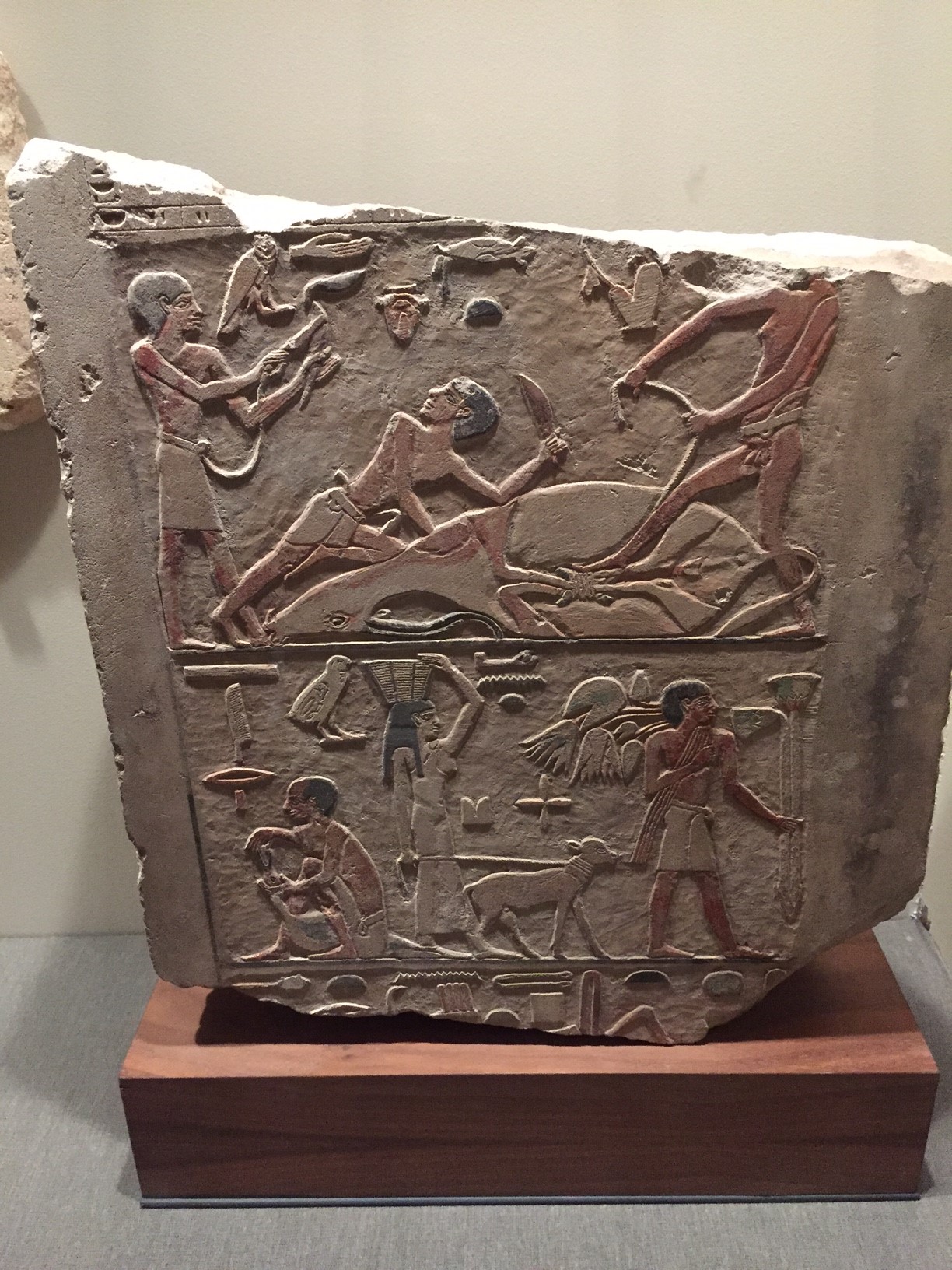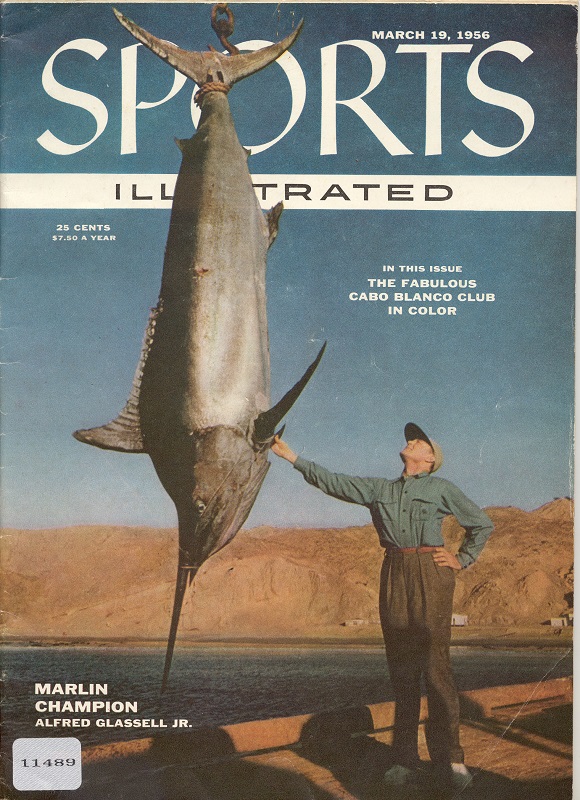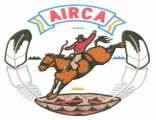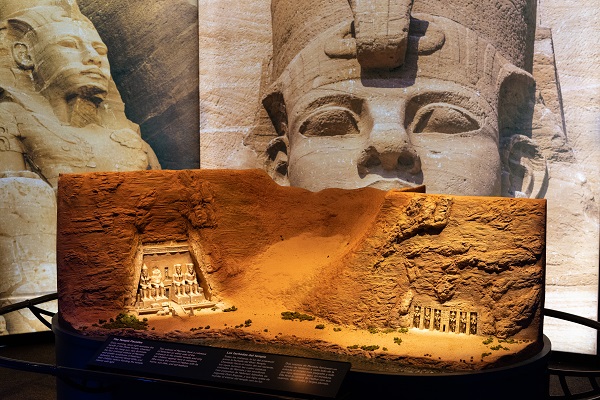Women in procession, with offerings to a deceased person. From our Hall of Ancient Egypt.
When people walk through our permanent exhibit halls, sometimes they come upon an object that makes them think “what in the world are they doing?”. It can be two fossilized skeletons posed in an unusual arrangement, or an artifact with a strange ritual depicted on it. This article will be the first in a weekly series entitled What In The World Are They Doing? to be published on our blog. This week we will focus on objects related to sacrifice in Ancient Egypt. This is a topic that we receive TONS of questions about.
When people think of sacrifice, they think of blood, guts, fire and altars. But that isn’t always the case. Although in some cultures sacrifice involves the ritual killing of animals or even people on holy spots, for many other cultures a sacrifice meant simply giving up something to a holy institution. The gods of Ancient Egypt didn’t like messy displays. They didn’t want gory spectacles—what they wanted was pretty things and good food.
This makes a lot of sense, considering the emphasis on “purity” in the temples of Egypt. For example, before entering a temple, priests were expected to remove all the hair from their bodies, shave their heads and dissolving the rest with a scary mixture of lime or other harsh chemical. Ancient texts also mention cutting the fingernails, washing ones body and applying oils. Priests also had to abstain from intercourse for several days before entering the temple. Outside the temple they could freely do whatever they wanted since being a priest in ancient Egypt was only a part-time job. Priests had a rotational system of temple servitude, serving one month and then going back to their normal business for the next three. In total, an Egyptian priest only served three months out of the year.
And speaking of priests, not everyone who worked for the temple would have performed religious ceremonies. In fact, the vast majority would never have even seen the actual temple deity statue. This is because the temples of Ancient Egypt were the center of their local economies and employed thousands of people. Most of which were not educated in religious practices, they were simply bureaucrats, farmers or butchers. The temple complexes controlled hundreds of miles of farmland, herds of cattle and trade for luxury goods. These were complex institutions that helped to run the country and the rituals of thanking the gods were as cosmopolitan as their busy, port-side trading centers.
In the bottom register of the stela above we see one man force feeding a goose to fatten it up. Above that we see two other men getting ready to slaughter an ox. These animals are offerings intended to be given to the gods, but they are not being killed in the temple on an altar—they are instead butchered by professionals. For the Ancient Egyptians the leg of an ox was the most choice cut of meat and it is depicted in numerous offering stelae in our Hall of Ancient Egypt. The gods would be “fed” all of the most delicious food both prepared and preserved. Afterwards, the food would be redistributed back to the priests as payment for their services or sometimes even sold on the market.
Something else that you will see in the Hall is mummified animals. Literally millions of mummified animals have been discovered in Egypt. Animals were considered to have a closer relationship to the gods than people do, some were even considered to be the living personification of a god. Being institutions of wealth and trade, many temples had farms which specialized in raising animals for the sole purpose of slaughtering them , mummifying them and selling them to the pious in the market. Once again though, the killing would not be done before the statues of the gods. Animals would be offered wrapped up like mummies: decorated, clean and presentable.
Our collection of animal mummies in the Hall of Ancient Egypt
In our Hall, there are some interesting offering tables with channels carved around the edges of them. In the center there are images of legs of oxen, bread, fruits and vegetables. These are meant to be offerings for the dead. The Ancient Egyptians believed that one should leave offerings not only for the gods, but also for deceased ancestors, who were often deified. Instead leaving physical food for the deceased-which could be expensive or difficult- one could simply pour water over the images. The water, through the contact with the mystical encantations carved on the offering table, would ensure the the deceased were fed in the afterlife.
Ceramic offering table with ox, and vegetable food items. Note the channels meant to capture an drain the water that would be poured over the images.
“Deluxe” carved limestone offering table, including hieroglyphic encantations.
So Ancient Egyptian sacrifice isn’t all about pretty ladies tied to altars, in fact it has nothing to do with that. Sacrifice in Ancient Egypt meant doing whatever you could to show your devotion to the gods. Whether that be through hygiene, delicious foods or simply a trip to an altar with some water.
All of the items pictured in this article are from our Hall of Ancient Egypt, here at HMNS. Come check them out! There’s tons more to learn!












